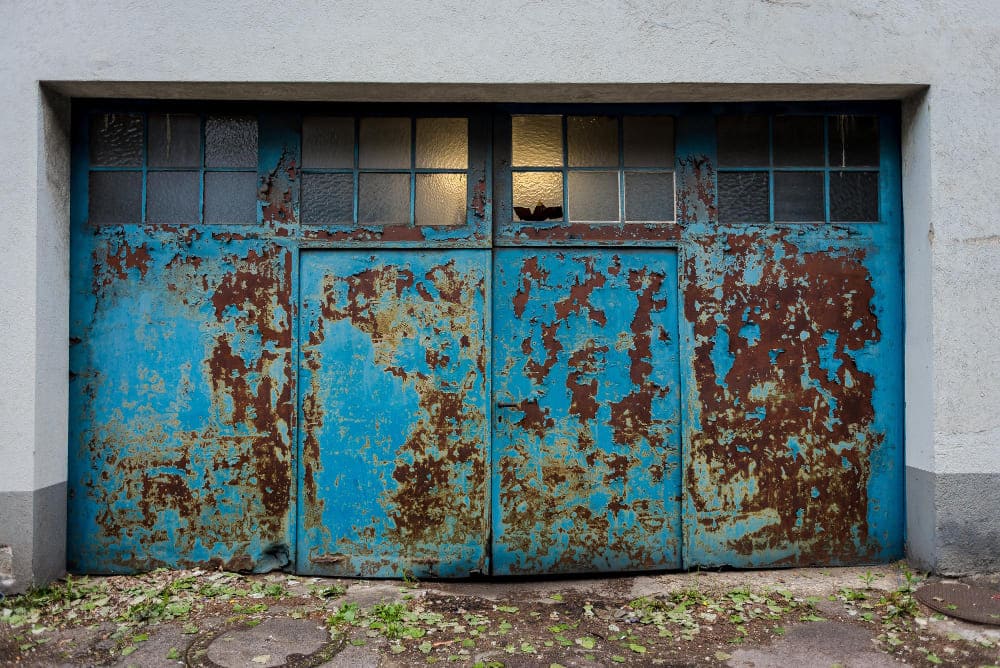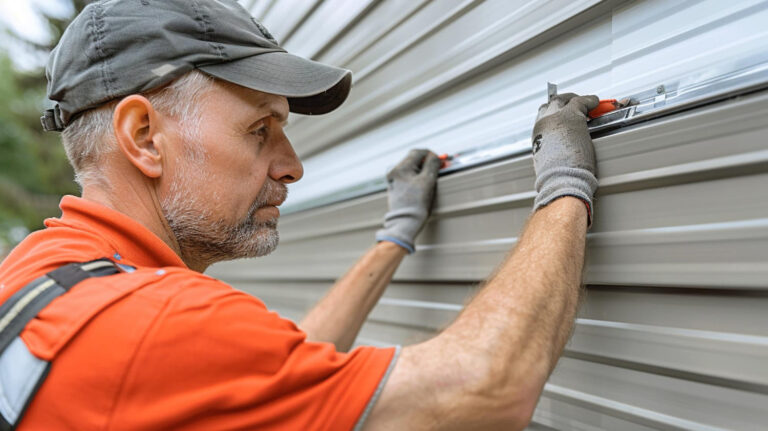Many homeowners eventually find painting garage doors to be a regular chore, particularly in cases of rusted garage doors. Rust compromises not just appearance but also structural integrity of your garage door. This thorough guide will walk you through many facets of rust and garage doors, answering basic questions including why rust occurs, how to prevent it, whether rusted garage doors can be repaired, how to remove rust, how to handle issues including painting over rust, fixing holes, and more.
Why Does a Garage Door Rust?
Rust garage door problems typically stem from environmental exposure. Garage doors, particularly metal ones, are often exposed to the elements, making them prone to rust. Here’s why rust forms on garage doors:
- Environmental Exposure:
Iron oxide, sometimes known as rust, is produced in chemical reaction by metal surfaces subjected to air and moisture. This is rather prevalent in coastal places especially where salty increases corrosion. Moreover promoting rust formation on garage doors are humid surroundings or those prone to regular rain. - Damaged Paint or Coating:
Damage to the paint or protective coating of the door exposes the underlying metal to moisture, which feeds rust development from scratches, dents, or other damage. Little mishaps like running a car against the garage door expose these defects. - Poor Quality Materials:
Older garage doors or those manufactured of poorer materials are more prone to rust from insufficient protective coatings. Though more modern doors often have superior rust-resistant coatings, older doors still bear some risk. - Lack of Maintenance:
Ignoring regular maintenance and cleaning for your garage door will cause dirt and moisture to build up, thereby hastening the rust development. Regular maintenance greatly lowers the possibility of rust development.
How to Prevent Rust on a Garage Door
Rusted garage doors can be an avoidable problem if you take the proper preventive measures. Here’s how to prevent rust from forming in the first place:
- Regular Cleaning:
Cleaning your garage door at least twice a year with a light detergent and water helps to prevent rust garage doors. Dirt, filth, and pollutants trapping moisture and generating rust will be helped by this as well. Once you clean, be sure the door dries completely. - Apply Protective Coatings:
By creating a barrier against moisture, applying wax or a protective sealer stops rusted garage doors from developing. Rust-inhibiting primers and exterior-grade coatings provide further door protection. - Lubricate the Hardware:
Also growing on the hinges, tracks, and other parts of a garage door is rust. Regular silicone-based lubrication of these parts helps prevent garage door rust and keeps them in smooth running order. - Inspect for Damage:
Regular check of your garage door for dents or scratches will help to expose the metal under and start rust. Should damage be found, fix it right once to stop garage door surfaces from corroding.
Can a Rusted Door Be Repaired?
Garage door in rust doesn’t necessarily mean that the door needs to be replaced. In many cases, you can repair the door depending on the extent of the rust damage:
- Surface Rust:
Rust garage doors with just little surface damage are rather easily restored. Using a rust-inhibiting primer, painting the door following sanding off the rust will assist to restore its appearance and stop more deterioration. - Deeper Rust or Pitting:
Repair would prove more difficult should the rust show pitting and chew into the metal. You will want to paint the door once more once the rust has been eliminated and any holes or pitting filled with metal filler. - Severe Rust Damage:
You should be thinking about door replacement should the rust affect the structural integrity of the door—that is, create big holes or breaks. Should the door be too far gone, repairs could reveal expensive and transient character.
What Can Break Garage Door Rust?
Garage door rust can often be removed or minimized with the right tools and techniques. Here are some effective methods to break and remove rust:
- Wire Brush and Sandpaper:
One can remove smaller rust areas with a wire brush or steel wool. Sandpaper can help to eradicate more difficult rust spots and smooth the surface. - Chemical Rust Removers:
Commercial rust removal products allow one to treat more sizable rusted garage door sections. These chemicals breakdown the rust so that it might be swept off. - Vinegar Solution:
A homemade vinegar and baking soda solution can also be quite successful for rust breaking. Treat the rusted area with the solution, let it sit for half an hour, then gently wash it.
Can You Paint Over a Rusty Garage Door?
Rusted garage door surfaces should not be painted over without proper preparation. Painting directly over rust will only trap the corrosion underneath, allowing it to continue spreading. Here’s how to properly paint a rusted door:
- Remove Rust First:
You have to clear any current rust before painting garage doors. Clear the rust using sandpaper or a wire brush; then, give the region overall cleaning. - Apply Rust-Inhibiting Primer:
After rust is removed, treat the door with primer-resistant corrosion protection. This ensures proper paint adherence and helps to prevent starting of more rust. - Use Exterior-Grade Paint:
Apply a premium exterior-grade paint designated for metal surfaces once the primer has cured. More defense against future rust will come from two paint treatments.
How Do You Fix a Garage Door After Hitting It with a Car?
Garage door painted surfaces can sometimes get damaged if hit by a car. Here’s how to fix a dented garage door after such an accident:
- Inspect the Damage:
Before starting any repairs, carefully check the garage door to find out whether the damage limits to a dent or whether it influences the door’s performance. - Heat and Cold Method for Dents:
Heat the area with a heat gun or hairdryer then rapidly cool it down with a can of compressed air or ice for small dents. Sometimes this pops the dent back out. - Use a Rubber Mallet:
Larger dents should be carefully tapped out from the inside using a rubber mallet. Take great care not to further compromise the door. - Panel Replacement:
Should the dent be too serious to repair, you could have to replace the garage door panel.
Can You Fix a Garage Door Yourself?
Rust on garage door surfaces or other garage door issues can often be fixed by homeowners with the right tools and knowledge. However, some repairs may require professional help:
- DIY Repairs:
Little problems like rust removal, repainting, and small dent correction may usually be handled personally with simple tools. For instance, adding fresh paint and sanding away garage doors in rust is easy. - When to Call a Professional:
Call a professional if the damage is severe, including structural concerns, major rust damage, or problems with the functionality of the door. Major repairs done on your own run the danger of causing more damage or safety issues.
What Does It Cost to Repair Garage Door Rust?
Garage door rust repair costs can vary depending on the severity of the rust and the size of the door. Here’s a breakdown of typical costs:
- Minor Surface Rust Repair:
Whether you do it professionally or personally, minor surface rust repair—should you simply need to remove surface rust and repaint the door—should run between $100 and $300. - Deeper Rust Repair:
Labor involved and the materials utilized will affect the cost of repairs involving more significant rust damage or pitting. - Replacing Severely Damaged Doors:
Should the door be too rusted to repair and requires replacement, the cost of a new door will range from $500 to $2,500 based on size and material.
How Do You Fix a Hole in a Metal Garage Door?
Rusted garage door surfaces may develop holes over time if the rust is left unchecked. Here’s how to fix a hole in a metal garage door:
- Clean the Area:
Before filling in the hole, tidy the surrounding area to eliminate trash, rust, and dirt. Sandpaper will help you to smooth the hole’s surrounds. - Apply Metal Filler:
For minor holes, fix them with a metal filler or epoxy putty. Smoothe it using a putty knife so the filler runs flat with the door’s surface. - Sand the Surface:
Once the filler has dry, sand the surface to provide a smooth finish. Once the door is painted, this will help the repair to be less obvious. - Repaint the Door:
After the hole has been fixed and sanded, primer and paint the door to match the rest of the surface.
Particularly in harsh environments, garage door painted surfaces are prone to rust and damage over time. Fortunately, with correct care and maintenance, rust on corroded garage doors can usually be eliminated and corrected. Early on damage should be addressed, protective coatings applied, and regular cleaning helps prevent rust from starting in first place. Whether your car has surface rust or dents,





